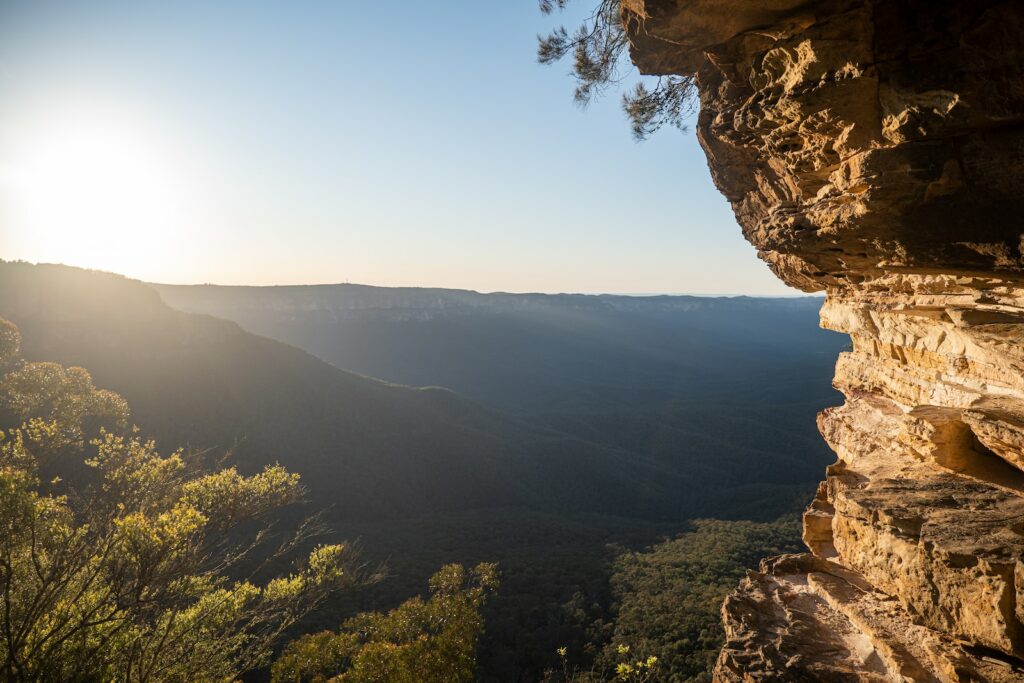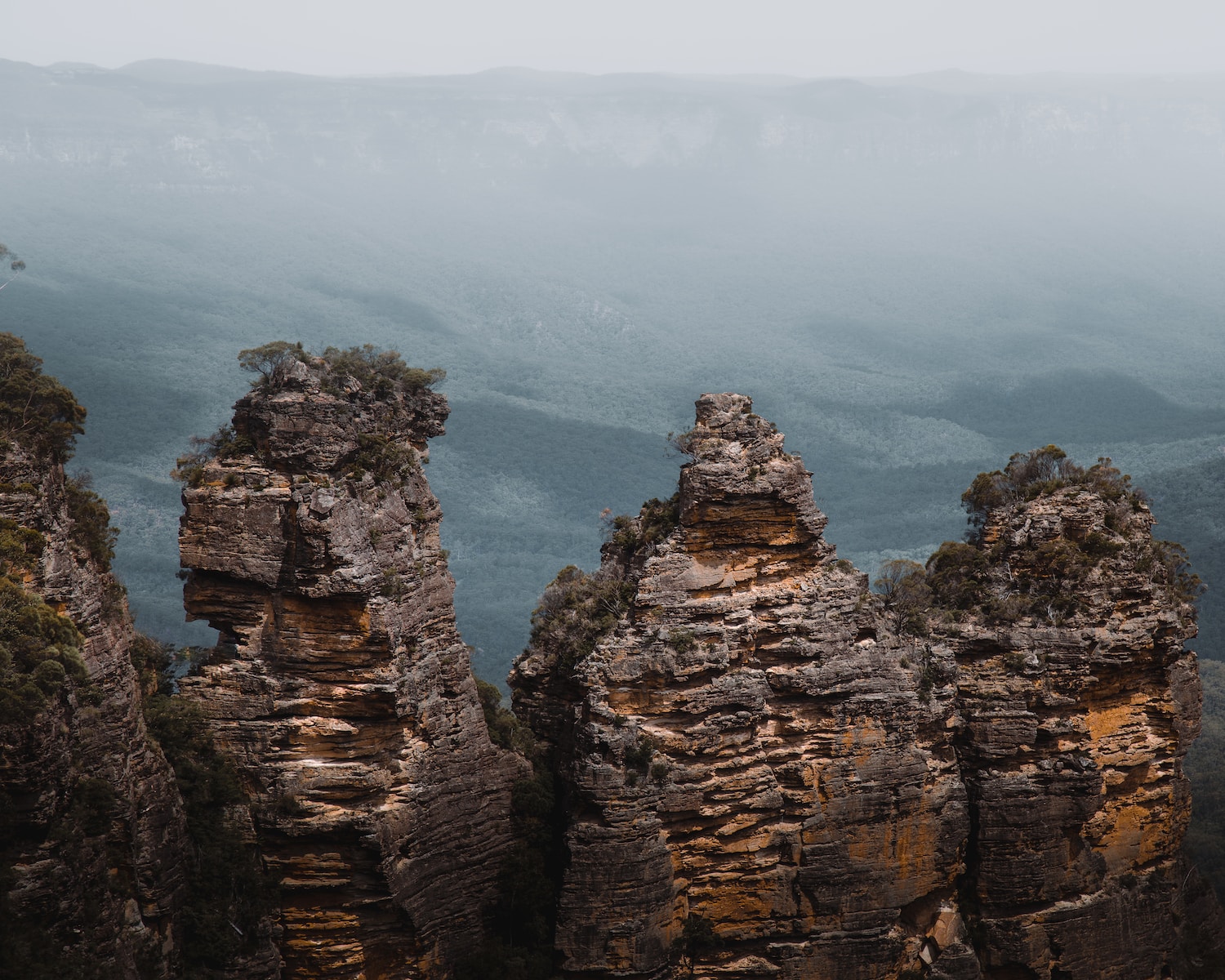The Three Sisters: Australia’s Rocky Beauties. Discover the striking landscape photography of The Three Sisters in Australia. Immerse yourself in the rich Aboriginal culture and history associated with these stunning rock formations. This blog provides an insight into the visual appeal of The Three Sisters and their deep connection to the Aboriginal people.
Table of Contents
The Three Sisters: Australia’s Rocky Beauties
The Three Sisters are a famous rock formation located in the Blue Mountains of New South Wales, Australia. These three distinct peaks are named “Meehni,” “Wimlah,” and “Gunnedoo” and are part of the Greater Blue Mountains World Heritage Area. The Three Sisters are a popular tourist attraction and are known for their unique geological features, as well as their cultural significance to the Aboriginal people of the region. Visitors can enjoy stunning views of the Three Sisters from various viewpoints and walking trails in the Blue Mountains, making it a prominent natural landmark in Australia.
The Best Time to Photograph The Three Sisters
The best time to photograph the Three Sisters in the Blue Mountains of Australia largely depends on your preferences and the type of photographs you want to capture. Here are some considerations for different times of the day and year:
- Sunrise: Many photographers consider sunrise the best time to photograph the Three Sisters. The soft morning light, often with colorful hues, can create a magical atmosphere. You’ll also have fewer tourists around at this time, allowing for more peaceful shots.
- Sunset: Sunset is another excellent time for photography. The warm, golden light of the setting sun can cast beautiful shadows and highlights on the rock formation. It’s a popular time for photographers, so arrive early to secure a good spot.
- Blue Hour: The period of time just before sunrise and after sunset, known as the “blue hour,” can yield stunning photographs. The soft, diffused light during this time can highlight the Three Sisters against the twilight sky.
- Autumn: If you want to capture vibrant foliage, visit during the autumn months (March to May). The changing colors of the surrounding trees can add a beautiful backdrop to your photos.
- Winter: Winter (June to August) can offer unique photo opportunities if you’re lucky enough to capture the Three Sisters dusted with snow. The stark contrast between the white snow and the rock formation can be visually striking.
- Avoid Midday: Midday sun can create harsh shadows and wash out colors in your photographs. It’s generally not the best time for photography, but you can use this time to explore the area or take wider shots of the landscape.
Ultimately, the best time to photograph the Three Sisters depends on your creative vision and the specific look you want to achieve. Sunrise and sunset are often preferred by photographers for their soft, warm light and dramatic skies. However, the Blue Mountains and the Three Sisters offer photographic opportunities year-round, so you can plan your visit based on the type of shot you want to capture.
My Journey to the The Three Sisters
Imagine standing in front of towering rock formations that evoke a sense of mystery and wonder. This is the experience that awaits you at The Three Sisters, located in the heart of the Blue Mountains in Australia. As a landscape photographer, I have had the privilege of capturing the breathtaking beauty of these iconic rock formations and delving into their rich Aboriginal history.
Discovering The Three Sisters
It was an early morning when I set out on my journey to The Three Sisters. Armed with my camera and a sense of excitement to capture their magnificence, I hiked the well-trodden path that led me closer to these natural wonders. As the sun began to rise, casting a golden hue, the rock formations emerged from the mist, captivating me with their sheer grandeur.
As a photographer, I was drawn to the unique shapes and textures of The Three Sisters. Each one stood tall, reminding me of an ancient guardian silently watching over the region. The jagged edges and weathered surfaces offered a perfect subject for my lens, and I eagerly began capturing their beauty from different angles.
Connecting with Aboriginal Culture
While The Three Sisters are undoubtedly a sight to behold, their significance to Australia’s Aboriginal culture cannot be understated. According to ancient indigenous stories, these rock formations are three sisters turned to stone as a result of forbidden love. The local Gundungurra and Darug Aboriginal communities consider The Three Sisters as sacred sites, and they hold a deep spiritual connection to them.
As I photographed The Three Sisters, I couldn’t help but feel a sense of reverence, knowing the cultural significance they held. It is a testament to the harmony between nature and culture, as these rock formations are not only visually striking but also bear the weight of thousands of years of Aboriginal history.
A Visual Feast for Landscape Photography
The Three Sisters offer a wealth of photographic opportunities for enthusiasts and professionals alike. The dramatic lighting and ever-changing weather conditions in the Blue Mountains create a dynamic canvas to capture these rocky beauties. Whether it’s the vibrant colors that dance across the sky during sunrise or the moody atmosphere that blankets the landscape during misty mornings, every moment at The Three Sisters is a chance to capture a unique masterpiece.
I found that positioning myself on one of the surrounding viewpoints allowed me to frame The Three Sisters against the vastness of the Blue Mountains, emphasizing their monumental scale. Experimenting with different compositions, using leading lines or incorporating nearby flora, added depth and visual interest to my photographs.
Moreover, the accessibility of The Three Sisters makes it an ideal destination for both experienced landscape photographers and amateurs looking to refine their skills. With numerous vantage points and walking trails, there are endless possibilities to capture the majesty of these natural wonders.
Visiting The Three Sisters was truly an awe-inspiring experience that left me with a deep appreciation for their beauty and cultural significance. Whether you are a photography enthusiast, history lover, or simply an admirer of nature’s wonders, The Three Sisters is undoubtedly a must-visit destination. Immersed in Aboriginal culture and embraced by breathtaking landscapes, they are a testament to Australia’s unique allure. So pack your camera, prepare your senses, and embark on an unforgettable journey to The Three Sisters, where the past merges effortlessly with the present.

Frequently Asked Questions
1. What are The Three Sisters in Australia?
The Three Sisters are a famous rock formation located in the Blue Mountains of New South Wales, Australia. They are three towering sandstone peaks that stand side by side, creating a breathtaking natural sight.
2. How were The Three Sisters formed?
The Three Sisters were formed millions of years ago through erosion caused by wind and rain. The soft sandstone of the region gradually wore away, leaving behind these stunning rock formations.
3. Can you visit The Three Sisters?
Yes, The Three Sisters are open to the public for visitation. There is a scenic lookout area that provides a stunning view of the rock formation and the surrounding landscape. Visitors can also explore the nearby walking trails and experience the beauty up close.
4. Are there any Aboriginal cultural connections to The Three Sisters?
Yes, The Three Sisters hold great significance in Aboriginal culture. According to the local Aboriginal legend, the rocks are the petrified forms of three sisters from the Katoomba tribe. The legend tells a story of forbidden love, explaining how the sisters were turned into stone to protect them during a tribal battle.
5. Can I take photographs of The Three Sisters?
Yes, photography is allowed and highly encouraged at The Three Sisters. The unique rock formations and the stunning backdrop of the Blue Mountains make for incredible landscape photography opportunities. Just be sure to respect any signage or guidelines in place to ensure the preservation of this natural wonder.
6. Is there any accommodation available near The Three Sisters?
Yes, there are various accommodation options available near The Three Sisters. The nearby town of Katoomba offers a range of hotels, guesthouses, and self-contained cottages for visitors to choose from. Staying in the area allows for easy access to the rock formation and other attractions in the Blue Mountains.
Wrap Up
In conclusion, The Three Sisters in Australia are a true marvel of nature. Their breathtaking rock formations and captivating beauty attract visitors from all over the world. But there is more to these rocky beauties than meets the eye.
Exploring the Aboriginal culture associated with The Three Sisters adds a deeper significance to the experience. Discovering their rich history and the legends behind them is a journey worth taking.
Whether you’re an avid landscape photographer or simply someone who appreciates natural wonders, The Three Sisters will surely leave you in awe.
Have you visited The Three Sisters? Share your thoughts and experiences with us in the comments below! Engage with us and let’s keep the conversation going.



